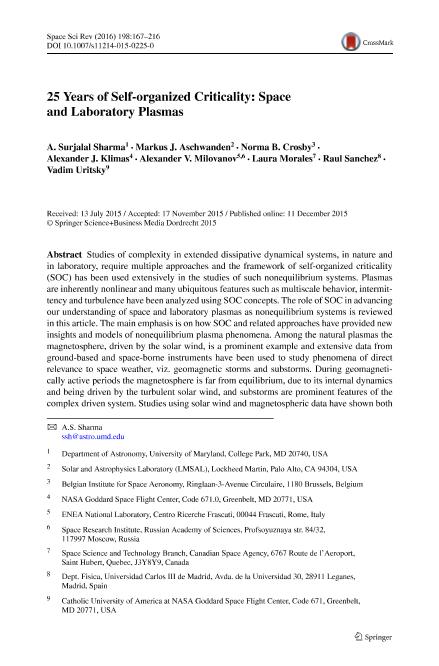Artículo
25 Years of Self-organized Criticality: Space and Laboratory Plasmas
Sharma, A. Surjalal; Aschwanden, Markus J.; Crosby, Norma B.; Klimas, Alexander J.; Milovanov, Alexander V.; Morales, Laura Fernanda ; Sanchez, Raul; Uritsky, Vadim
; Sanchez, Raul; Uritsky, Vadim
 ; Sanchez, Raul; Uritsky, Vadim
; Sanchez, Raul; Uritsky, Vadim
Fecha de publicación:
01/2016
Editorial:
Springer
Revista:
Space Science Reviews
ISSN:
0038-6308
Idioma:
Inglés
Tipo de recurso:
Artículo publicado
Clasificación temática:
Resumen
Studies of complexity in extended dissipative dynamical systems, in nature and in laboratory, require multiple approaches and the framework of self-organized criticality (SOC) has been used extensively in the studies of such nonequilibrium systems. Plasmas are inherently nonlinear and many ubiquitous features such as multiscale behavior, intermittency and turbulence have been analyzed using SOC concepts. The role of SOC in advancing our understanding of space and laboratory plasmas as nonequilibrium systems is reviewed in this article. The main emphasis is on how SOC and related approaches have provided new insights and models of nonequilibrium plasma phenomena. Among the natural plasmas the magnetosphere, driven by the solar wind, is a prominent example and extensive data from ground-based and space-borne instruments have been used to study phenomena of direct relevance to space weather, viz. geomagnetic storms and substorms. During geomagnetically active periods the magnetosphere is far from equilibrium, due to its internal dynamics and being driven by the turbulent solar wind, and substorms are prominent features of the complex driven system. Studies using solar wind and magnetospheric data have shown both global and multiscale features of substorms. While the global behavior exhibits system-wide changes, the multiscale behavior shows scaling features. Along with the studies based on observational data, analogue models of the magnetosphere have advanced the understanding of space plasmas as well as the role of SOC in natural systems. In laboratory systems, SOC has been used in modeling the plasma behavior in fusion experiments, mainly in tokamaks and stellarators. Tokamaks are the dominant plasma confinement system and modeling based on SOC have provided a complementary approach to the understanding of plasma behavior under fusion conditions. These studies have provided insights into key features of toroidally confined plasmas, e.g., the existence of critical temperature gradients above which the transport rates increase drastically. The SOC models address the transport properties from a more general approach, compared to those based on turbulence arising from specific plasma instabilities, and provide a better framework for modeling features such as superdiffusion. The studies of space and laboratory plasmas as nonequilibrium systems have been motivated by features such as scaling and critical behavior, and have provided new insights by highlighting the properties that are common with other systems.
Archivos asociados
Licencia
Identificadores
Colecciones
Articulos(INFINA)
Articulos de INST.DE FISICA DEL PLASMA
Articulos de INST.DE FISICA DEL PLASMA
Citación
Sharma, A. Surjalal; Aschwanden, Markus J.; Crosby, Norma B.; Klimas, Alexander J.; Milovanov, Alexander V.; et al.; 25 Years of Self-organized Criticality: Space and Laboratory Plasmas; Springer; Space Science Reviews; 198; 1; 1-2016; 167-216
Compartir
Altmétricas



